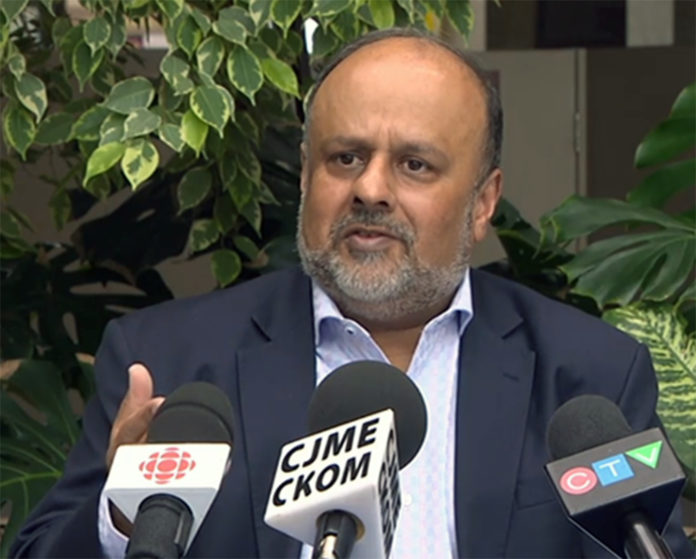
Saskatchewan’s vaccine program is already showing some success in preventing cases of COVID-19, the province said Tuesday.
During the twice-weekly media briefing, Chief Medical Health Officer Dr. Saqib Shahab said that only 0.09 per cent of new cases were in people who had just one shot of vaccine in their arms and at least 14 days to begin building immunity. That’s an efficacy rate of 99.91 per cent. Shahab mused that it would be even higher, providing even more protection, once both vaccines are administered.
Premier Scott Moe is also hopeful that a second dose will mean fewer travel restrictions for Saskatchewan residents. The federal government, though, has remained mum on what fully vaccinated Canadians could expect.
Prime Minister Justin Trudeau Tuesday encouraged provinces to hold off lifting restrictions until more people are vaccinated and case counts start to decline.
He described 2021 as a single dose summer.
In Saskatchewan, though, Moe disagrees.
“We’re not going to have a one-dose summer. We’re going to have a one-dose spring and a two-dose summer,” Moe said.
He added that he’s confident with the vaccine uptake he’s seen, especially among the province’s oldest residents. He’s confident that once Saskatchewan reaches the point of its phase 2 reopening, it will be in a situation like the one Trudeau described.
It’s still a few weeks away from even the first reopening. While Saskatchewan hit the vaccine uptake level required for that first phase, the plan sees a three-week lag time from the date the metric is reached to the reopening to allow that immunity to build up.
“Your immunity starts developing two weeks after (the shot) and after three weeks it’s better,” Shahab said.
“Ultimately, but the time we move forward with the phase two reopening, three weeks after two criteria are met, it’s quite likely we’ll have a very high vaccination rate,” Moe added.
“We’ll be into our second doses. We’re not just going to turn a switch and the economy comes on … when we reach some magic number.”
He said that people have to be given time to reintegrate back and adjust to what life used to be life.
He called on the federal government to provide a look at what a fully-vaccinated Canadian might be able to do — such as travel internationally without quarantining upon return — that unvaccinated residents can’t.
“Very soon we will have a lot of people in Saskatchewan who are fully vaccinated,” Moe said.
“I understand we’re not at that point today, but I would like the federal government to start to provide guidelines on these matters to incentivize people to make sure they’re not stopping after one shot and going back to get their second.”
Moe was also pressed on how to tackle vaccine hesitancy among younger age groups. Moe denied the presence of such hesitancy, citing vaccination rates that continue to slowly climb upwards, even as those increases begin to level off in some age groups.
As of Tuesday, residents in their 50s had an uptake of just 67 per cent, despite becoming eligible weeks ago. Residents in their 40s were 55 per cent vaccinated and Saskatchewan residents aged 30-39 had a 28 per cent uptake, despite most becoming eligible in just the past week.
Shahab said that across some of the younger age groups, it has been common to see a high uptake at first, and then a levelling off as fewer people get the vaccine.
“It’s essential we quickly take up our first dose when we become eligible and … when second doses are scheduled and announced we quickly complete the series,” he said.
“They are coming in abundance now. We must make sure we take the vaccines as soon as they come, which will help us reach closer to our goals of community immunity and a safe reopening.”
Moe, though, said he didn’t think there was much vaccine hesitancy. He also said that Saskatchewan is doing well at appealing to younger audiences to receive a vaccine.
“We’ve seen additional ads come out with Roughriders and others that would resonate with the 20-40 age group,” he said, adding that the paid three-hour vaccine leave should also help younger residents, many of whom work full-time in essential jobs, find time to get their vaccination.
“I would ask our younger aged people to really take inspiration from their parents and grandparents who have shown up in very high percentages,” Moe
“For people who haven’t come forward, there’s no reason to delay, Shahab said.
“COVID is going to be around and it can have unpredictable and serious consequences. The more of us that are vaccinated, the more of that community immunity we have.”
More AstraZeneca not expected, residents to receive Pfizer for second shot
The province is looking more closely at using Pfizer as the second dose for people who received AstraZeneca the first time around as it’s not expected that the province will receive more anytime soon and its supply has almost run out.
Shahab cited studies in the UK which appear to show in preliminary results that using Pfizer for a second dose after someone has received a first dose of AstraZeneca is as effective as using AstraZeneca for both doses.
“Pfizer is equally safe and effective, but over the next few weeks we’ll get more information to confirm that,” he said.

